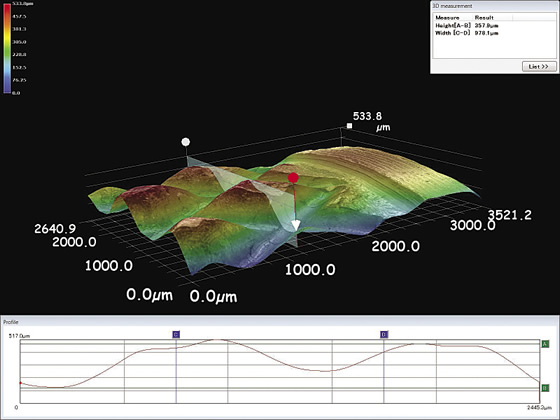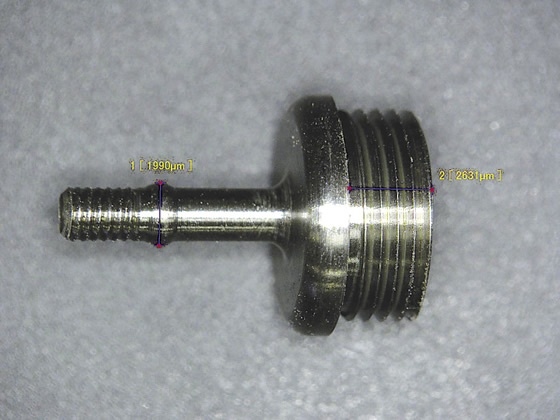END USER: Protomatic Inc., (734) 426-3655, www.protomatic.com.
CHALLENGE: Improve cross-hole deburring and training with real-time video.
SOLUTION: A super-resolution digital microscope.
SOLUTION PROVIDER: Keyence Corp. of America, (888) 539-3623, www.keyence.com.
Having real-time video observation of a metalworking operation enables a manufacturer to improve employee training and, ultimately, its finished products. Customers are also impressed by seeing their parts receive the finishing touches with a technician who is using a microscope.
One company using this strategy is Protomatic Inc. It manufactures precision medical parts, some with multiple cross-holes. Many of these cross-hole parts are made of stainless steel, titanium, aluminum and plastic, and cannot be obstructed by burrs because they carry fluids, according to Doug Wetzel, vice president and general manager of the Dexter, Mich., prototype and production machine shop.
Accurate deburring of these tiny cross-holes is critical to the performance of the customer’s part. The burrs are so fine that the naked eye cannot see them to remove them, and, typically, an optical stereo microscope is used when deburring.

The Keyence VHX-2000 super-resolution digital microscope allows Protomatic to view details of formed knurls and measure knurl height.
A conventional microscope works well for a single user, but a real-time video camera is attached for training purposes. Usually, these video systems are USB-based, creating a short delay on the video screen, Wetzel noted. “Standard stereo optical microscopes don’t offer you the ability to do training with them unless you have a high-end, two-person scope,” he said. “With a USB video system in use on an optical scope, the projection delay from what the hand is doing to what is shown on the screen prevents accurate deburring. Optical microscopes also have a shallow depth of field.”
While visiting IMTS 2012, Wetzel dropped by the Keyence Corp. of America exhibit and expressed interest in the Elmwood Park, N.J.-based company’s VHX-2000 super-resolution digital microscope, recalled Garrett Dolhon, senior sales engineer for Keyence’s Micro Analysis Group and located in Farmington Hills, Mich. “We first looked at inspecting their medical parts for burrs,” he said. “The second thing we looked at was 3-D measurements of the knurls on some parts.”
Wetzel emphasized the microscope’s speed when performing the latter application, noting the VHX-2000 programming consumes only about a minute and part scanning takes 20 to 30 seconds.
For training, being able to capture detailed scanned images and project them onto a 30 " screen provides educational benefits for customers and employees, Wetzel noted. The system also enables the shop to document the scan with a PDF and e-mail it to a customer or store it for measurement certification.
Compared to many of the traditional optical microscopes used by machinists throughout the shop, the super-resolution digital microscope has a 20-times-greater depth of field. This eliminates manually moving the focal field and remembering what was being viewed over the entire part length, Wetzel pointed out. “The greater depth of field means you’re not refocusing all the time,” he said. “With the VHX-2000, you could stand a quarter up on edge and see the top and bottom of the quarter in focus.”

Protomatic measures critical features on a tube connector with its VHX-2000 super-resolution digital microscope.
To achieve even higher resolution and clarity, the digital microscope has a color wheel with a red, green and blue filter, allowing a user to pass the white light from the built-in light source through a filter to see details not visible or not clearly visible with the white light. Dolhon explained that the highest super-resolution imaging function combines blue light, which has the shortest wavelength, with the ability of the CCD (charge-coupled device) in the camera to physically shift three times in each direction. This shifting divides each pixel into nine “subpixels,” improving resolution, he added, noting the microscope captures up to 54 megapixels of information.
By being able to resolve more information and see more of a part in focus, users have an easier time distinguishing features. Knowing where a particular feature stops and starts greatly improves measurement accuracy, Dolhon added.
According to Protomatic, having a super-resolution digital microscope that captures part topography and provides a greater depth of field than an optical scope gives the company and its customers a view of parts beyond anything they’ve seen before.
Related Glossary Terms
- 3-D
3-D
Way of displaying real-world objects in a natural way by showing depth, height and width. This system uses the X, Y and Z axes.
- metalworking
metalworking
Any manufacturing process in which metal is processed or machined such that the workpiece is given a new shape. Broadly defined, the term includes processes such as design and layout, heat-treating, material handling and inspection.







